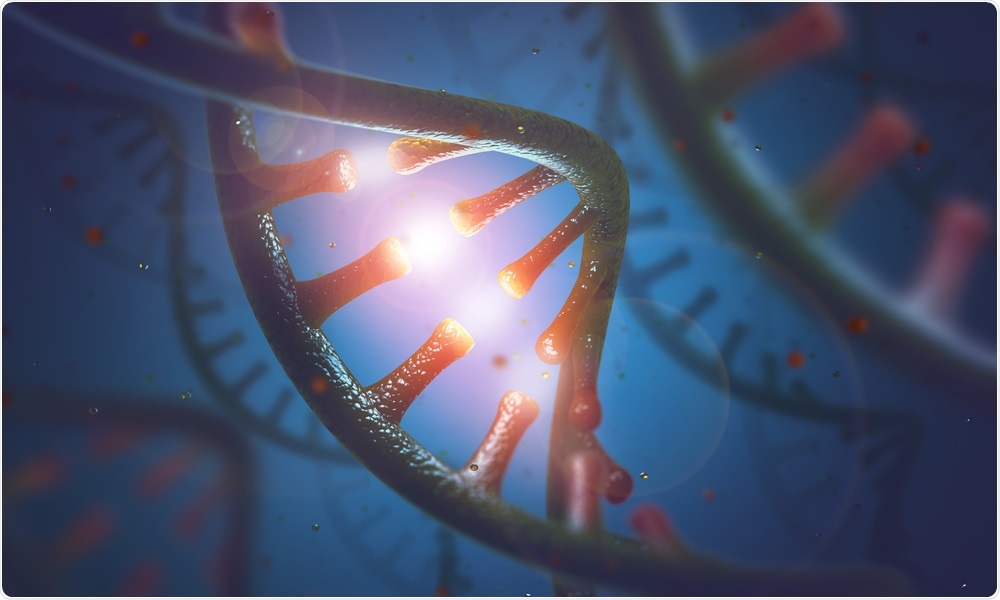RNA polymerase (RNAP) is the enzyme responsible for transcription in eukaryotic cells. Unlike bacterial cells where a single RNAP facilitates transcription, there are three types of RNAP in eukaryotes which play different roles in gene expression.
 Image Credit: Ktsdesign / Shutterstock
Image Credit: Ktsdesign / Shutterstock
RNA Polymerase Structure
Subunits
All three RNAPs have catalytic cores consisting of 10 subunits. Five of these are core subunits which form crab claw shapes with DNA at their centres, channels for RNA products and NTP substrates as well as an additional 5 units.
The claw like shape stabilizes the DNA and enables the correct formation of transcription bubbles (regions where DNA strands have unwound near genes which are to be transcribed.) RNAP II is only made up of 12 subunits in total. Along with the 10 catalytic subunits found in all RNAPs, RNAP II has two Rpb4⧸7 which initiation transcription.
RNAP II is the enzyme primarily responsible for the synthesis of messenger RNA (mRNA). RNAP I and III contain an extra heterodimeric subunit. RNAP III alone has a heterotrimeric subunit, giving a total of 17 subunits.
Repeat sequences
RNAP II has several repeat units located at its carboxyl end (Tyr-Ser-Pro-Thr-Ser-Pro-Ser) which are not found in either RNAP I or III. These repeats allow proteins to bind to the RNAP II molecule and initiate its activity.
Functional significance of subunits
The additional subunits found in RNAP III are thought to give the enzyme increased flexibility when compared to other RNAPs. While RNAP I (located in the nucleus) is solely responsible for the synthesis of the large ribosomal RNA (rRNA) subunit.
The highly abundant RNAP III, known for its stability, synthesises large amounts of tRNA, 5S rRNA and other products for protein synthesis. Both polymerases, play structural and catalytic roles within the cell.
Role of RNAP II in transcription
Binding to promoter
Regardless of species, RNAP plays a role in transcription. By binding to the promoter site on a DNA strand, RNAP along with transcription factors form a transcription pre-initiation complex (PIC). This initiates the process of transcription.
The promoter site is a region located upstream at the 5’ end of a DNA strand. An AT-rich TATA box is the most well-recognised promoter sequence and is used by RNAP II. However, this promoter is only found in approximately 10–15% of mammalian species.
Transcription factors like TFIID bind to the TATA box causing a dramatic change in the shape of the DNA stand. This allows other proteins to assemble at the promoter site with RNAP II, forming the transcription initiation complex (TIC).
Addition of phosphate groups
Phosphate groups are added to the tail end of RNAP II by TFIIH, releasing the enzyme so it can start the process of transcription. The transcription factors at the promoter site are then released and recycled, enabling them to begin a new round of transcription. Phosphatase removes the phosphate groups from RNAP II once the process of transcription is completed.
5’ Cap
The RNA is capped at the 5’ end. This cap consists of guanine and a methyl group. RNA polyadenylation occurs at the 3’ end, where the adenosine monophosphate repeats are added to the RNA molecule resulting in the formation of a poly A tail. This helps the smooth transfer of mRNA from the nucleus, increases it longevity in cell cytoplasm, and improves its translational efficiency.
Transcription Facilitated by RNA Polymerase I and III
The promoter sequence associated with the synthesis of rRNA is 150 base pairs in length. Two transcription factors, UBF and SL1 bind to the promoter and recruit RNAP I to the site.
The promoter sequences used by RNAP III differ from those used by other polymerases as they are internal promoters rather than in an upstream location. The transcription factor TFIIIC binds to the promoter located within the DNA strand and recruits TFIIIB upstream of the transcription start site.
The subsequent events are not well characterized, although it has been suggested that RNAP III dissociates slowly from its transcription factors resulting in a slow clearance from the initiation site.
Further Reading